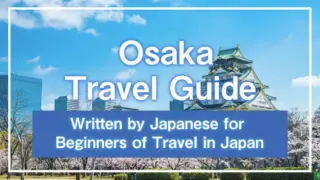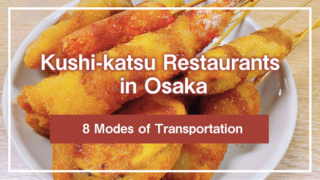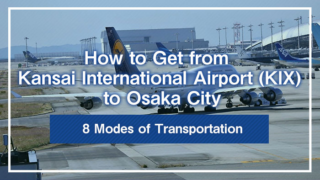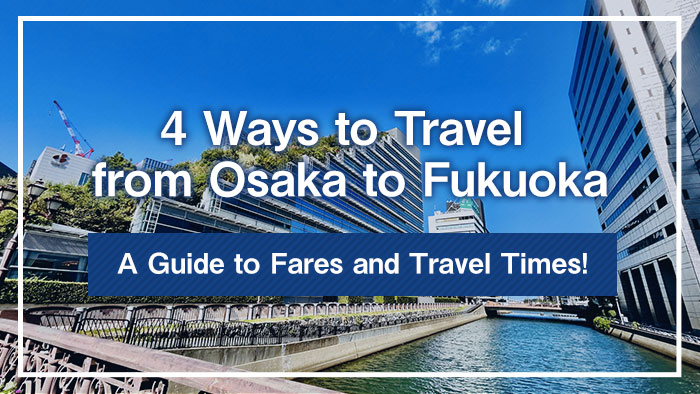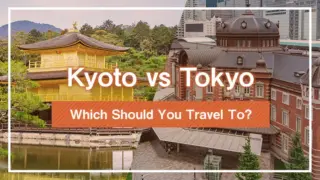If you’re looking for a balance between time and budget, the Shinkansen (bullet train) or airplane is recommended for traveling from Osaka to Fukuoka. The Shinkansen, in particular, is one of the more popular forms of transport, offering both speed and convenience. It takes approximately 2 hours and 30 minutes to travel from Shin-Osaka Station in Osaka to Hakata Station in Fukuoka. It’s also a great choice for those who wish to enjoy the view from the window and savor the Japanese landscape at a leisurely pace.
This article will explain four methods of traveling from Osaka to Fukuoka, including average fares and travel times.
1.Four Ways to Travel from Osaka to Fukuoka
Osaka and Fukuoka are attractive cities for foreign tourists visiting Japan. Osaka, as the heart of the Kansai region, has a vibrant atmosphere with a mix of tradition and the latest trends. Fukuoka, the gateway to Kyushu, offers the opportunity to enjoy delectable local dishes such as Hakata ramen and mentaiko.
This introduces four ways to travel from Osaka to Fukuoka.
1-1.Shinkansen (Bullet Train)
The Shinkansen, Japan’s high-speed rail, reaches top speeds of 320 km/h (about 200 miles per hour), connecting major cities across the country.
To travel from Osaka to Fukuoka (Hakata Station) by Shinkansen, you board at Shin-Osaka Station. Shin-Osaka is conveniently located and easily accessible from anywhere in Osaka city via subway or JR lines.
There are several types of Shinkansen, with the “Nozomi” being the fastest, making the journey from Osaka to Fukuoka (Hakata Station) in about 2 and a half hours. Although slightly more expensive, it stops at fewer stations and is quicker than other Shinkansen, with unreserved seat tickets costing 14,750 yen one-way, and reserved seats costing 16,020 yen one-way.
The “Hikari” and “Mizuho” trains stop at more stations than the “Nozomi”, meaning a slightly longer travel time, but still allow you to arrive in Fukuoka from Osaka in under 3 hours. The fare for these trains is 14,750 yen for an unreserved seat and 15,280 yen for a reserved seat one-way.
1-2.Airplane
Traveling by airplane from Osaka to Fukuoka is an excellent choice for travelers looking to save time.
Osaka is served by two major airports:
| Kansai International Airport (KIX) | Located to the south of Osaka city, it offers both international and domestic flights. |
|---|---|
| Itami Airport (ITM) | Primarily used for domestic flights, this airport is closer to the center of Osaka city. |
The destination airport, Fukuoka Airport (FUK), is very close to the center of Fukuoka city, making it conveniently accessible.
The flight itself takes about 1 hour and 10 to 20 minutes, but the time needed to travel to the airport, check-in, and going through security also must be considered. The total travel time can vary depending on how long it takes to get to the airport and the traffic conditions on the day, but it’s good to assume it will take around 3 hours in total.
The one-way fare from Osaka to Fukuoka by plane ranges from approximately 5,000 yen to 20,000 yen. Using a Low-Cost Carrier (LCC) can make the reservation cheaper than regular airlines.
1-3.Overnight Bus
Overnight express buses operate between Osaka and Fukuoka, making it a cost efficient mode of transportation for those looking for an economical option
In Osaka, overnight buses depart from major areas such as Umeda, Namba, and Tennoji. In Fukuoka, they primarily arrive at central locations such as Hakata Bus Terminal and the Tenjin area, allowing for immediate sightseeing or transit in Fukuoka city upon arrival.
The one-way fare for adults varies depending on the class of service, booking period, and bus company, but generally ranges from about 5,000 to 10,000 yen. The journey to Fukuoka, which includes breaks, takes about 8 hours.
1-4.Ferry
Ferries depart from Osaka Nanko or Izumiotsu Port and arrive at Shin-Moji Port in Kitakyushu City. The journey takes about 11 hours, with evening or night departures and morning arrivals, operating exclusively as overnight services.
While ferries take longer than airplanes or the Shinkansen, they are less expensive and offer a more relaxed experience on board. They are also an excellent option for those planning a driving trip around Kyushu, as it’s possible to bring cars or motorcycles aboard.
The fare for a one-way trip per person (without loading a vehicle or motorcycle) ranges from about 7,500 yen to 28,000 yen. The price varies depending on the type of room, service level, and time of use.
2.Things to Do in Osaka
Osaka is renowned for its vibrant culture, rich history, and world-class theme parks. Here are some experiences we recommend for international visitors to Osaka.
| Osaka Cuisine |
|---|
Osaka is known as Japan’s “city of gastronomy.” Trying local specialties like “okonomiyaki” and “takoyaki” is not to be missed. Takoyaki are balls of wheat flour batter filled with octopus, cooked to a round shape, and typically eaten with sauce, mayonnaise, and bonito flakes. Okonomiyaki is a savory pancake made from wheat flour batter mixed with cabbage, pork, seafood, etc., and enjoyed with sauce and mayonnaise. Both dishes are emblematic of Osaka’s food culture. You can enjoy authentic flavors in specialty shops around Dotonbori and Namba. Other popular street foods include kushikatsu (deep-fried skewered meat and vegetables), kitsune udon (udon noodles with fried tofu), grilled squid, and pork buns. |
| Universal Studios Japan (USJ) |
|---|
The globally famous theme park, USJ, offers attractions based on movies and animations. Attractions cater to a wide range of ages, featuring Super Mario, Harry Potter, Minions, and Jurassic Park, among others. USJ continually incorporates the latest technology into its attractions, offering cutting-edge experiences with VR and AR for unparalleled immersion. |
| Osaka Castle |
|---|
Osaka Castle is a leading tourist attraction and a symbol of the city. Built in the 16th century by the famed general Toyotomi Hideyoshi, the castle stands as a testament to the power and prosperity of the era. Its main tower is adorned with gold leaf, showcasing luxurious architecture. Exploring the vast grounds offers a glimpse into the paths walked by samurai warriors during the Sengoku (warring states) period. In addition to the main tower, Osaka Castle also boasts gardens, museums, and other sightseeing spots. The view from the tower provides a panoramic look at Osaka’s cityscape, while the gardens display a beautiful array of flowers throughout the seasons. The museum offers insights into Osaka’s history and culture. |
3.Things to Do in Fukuoka
Fukuoka is a city packed with history, culture, gourmet food, and hot springs. Here are some experiences you shouldn’t miss when visiting Fukuoka.
| Fukuoka Gourmet |
|---|
Fukuoka is a foodie’s paradise with a wide variety of dishes to try. A must-try is “Hakata Ramen,” known for its rich pork bone-based broth and thin noodles. Another Fukuoka specialty is “Motsunabe,” a hot pot dish made with beef or pork offal, cooked in soy sauce or miso. “Mizutaki,” a hot pot with chicken and vegetables simmered in a kelp broth, represents Fukuoka’s winter cuisine. Beyond these, Fukuoka offers many more delightful dishes, including mentaiko (spicy cod roe), karashi mentaiko, and “kashiwa rice” (chicken rice). Furthermore, Fukuoka features over 100 “yatai” (street food stalls), embodying the city’s nighttime charm. These stalls offer affordable meals, allowing you to enjoy Fukuoka’s staple dishes like ramen and motsunabe for around 1,000 yen. |
| Dazaifu Tenmangu Shrine |
|---|
Dazaifu Tenmangu is a vast shrine located in Dazaifu City, Fukuoka. It enshrines “Sugawara Michizane,” known as the god of learning, attracting students and those praying for success from all over the country, making it one of Kyushu’s most popular tourist spots. The allure of Dazaifu Tenmangu lies in its rich historical and cultural significance. The shrine is surrounded by nature, and in spring, about 6,000 plum trees blossom, providing a breathtaking sight for visitors. Many of Dazaifu Tenmangu’s buildings, including the prayer hall, are designated as Important Cultural Properties of Japan. The “Nagi no Ki,” a giant camphor tree over 1,000 years old, is considered a national treasure. The serene ambience of the shrine’s grounds are worth exploring for their sheer beauty. |
| Itoshima and Nokonoshima |
|---|
Itoshima, a peninsula located west of Fukuoka City, is known for its beautiful coastline, fresh local seafood, and art. It’s an ideal place for outdoor activities like surfing, camping, and hiking, offering plenty of ways to enjoy nature. Nokonoshima is an island off the coast of Itoshima. It’s perfect for day tripes, taking only 10 minutes by ferry from Fukuoka city. Nokonoshima offers lush nature and activities like swimming, camping, and fishing. Despite its small size, the island’s white sandy beaches and emerald-green sea are breathtaking. |
Conclusion
Traveling by overnight bus is the most budget-friendly choice to travel from Osaka to Fukuoka. It saves on accommodation costs since you’re traveling at night, but keep in mind that it may be more physically exhausting than other options
While not mentioned this time, if you have an international driving permit, renting a car is another option. It allows for travel at your own pace and the freedom to stop at tourist spots along the way.
Osaka and Fukuoka are popular cities not just with international visitors but also among Japanese people. Enjoy your trip to Osaka and Fukuoka to the fullest.
*This article is based on information available as of April 2024.

